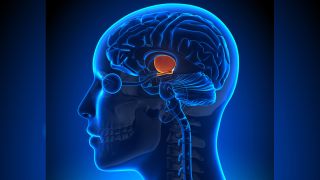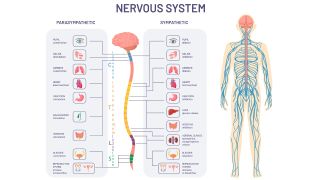Fight or flight: The sympathetic nervous system
The sympathetic nervous system is your body's built-in alarm system.

When faced with imminent physical danger, the human body’s sympathetic nervous system triggers our "fight-or-flight" response. The sympathetic nervous system is a normally harmonized network of brain structures, nerves and hormones that, if thrown off balance, can result in serious complications.
What is a sympathetic nervous system?
The sympathetic nervous system makes up part of the autonomic nervous system, also known as the involuntary nervous system. Without conscious direction, the autonomic nervous system regulates important bodily functions such as heart rate, blood pressure, pupil dilation, body temperature, sweating and digestion, according to a review in the American Journal of Pharmaceutical Education. Research suggests that distinct types of nerve cells, called neurons, control these different physical reactions by directing the action of skeletal muscle, cardiac muscle and gland secretion. The system allows animals to make quick internal adjustments and react without having to think about it.
The sympathetic nervous system directs the body's rapid involuntary response to dangerous or stressful situations. A flash flood of hormones boosts the body's alertness and heart rate, sending extra blood to the muscles. Breathing quickens, delivering fresh oxygen to the brain, and an infusion of glucose is shot into the bloodstream for a quick energy boost. This response occurs so quickly that people often don't realize it's taken place, according to Harvard Medical School. For instance, a person may jump from the path of a falling tree before they fully register that it's toppling toward them.
The sympathetic nervous system doesn't destress the body once the tree is felled or the danger has passed. Another component of the autonomic nervous system, the parasympathetic nervous system, works to calm the body down, according to the Clinical Anatomy of the Cranial Nerves, published in 2014 by Academic Press. To counter the fight-or-flight response, this system encourages the body to "rest and digest." Blood pressure, breathing rate and hormone flow return to normal levels as the body settles into homeostasis, or equilibrium, once more.
The sympathetic and parasympathetic nervous systems work together to maintain this baseline and normal body function.
How is the sympathetic nervous system organized?
Structures in the brain, spinal cord and peripheral nervous system support the function of the sympathetic nervous system, according to a 2016 review in the journal BJA Education. Receptors in internal organs of the chest and abdomen collect information from the body and send it up to the brain through the spinal cord and cranial nerves. The hypothalamus, a brain structure important for regulating homeostasis, receives signals from the body and tunes the activity of the autonomic nervous system in response.
This brain structure also gathers information from areas higher in the brain, such as the amygdala, according to a review in the journal Biological Psychiatry. Often called the emotional brain, the amygdala pings the hypothalamus in times of stress.

The hypothalamus then relays the alert to the sympathetic nervous system and the signal continues on to the adrenal glands, which then produce epinephrine, better known as adrenaline. This hormone triggers the profuse sweating, rapid heartbeat and short breaths we associate with stress. If the danger persists, the hypothalamus sends a new message through the nerve system grapevine, instructing the adrenal glands to produce the hormone cortisol to keep the stress response rolling.

Outgoing commands from the sympathetic nervous system exit the spinal cord in the thoracolumbar region, or the mid to lower spine. Sympathetic neurons exit the spinal cord and extend in two columns on either side of it. These neurons then tag a second set of nerve cells into the relay, signaling them with help from the chemical messenger acetylcholine.
Having picked up the baton, the second set of neurons extends to smooth muscles that execute involuntary muscle movements, cardiac muscles and glands across the body. Often, the parasympathetic nervous system communicates with the same organs as the sympathetic nervous system to keep the activity of those organs in check.
What happens when it doesn't work?
The sympathetic and parasympathetic nervous systems rest on either side of a wobbling scale; each system remains active in the body and helps counteract the actions of the other. If the opposing forces are mostly balanced, the body achieves homeostasis and operations chug along as usual. But diseases can disrupt the balance.
The sympathetic nervous system becomes overactive in a number of diseases, according to a review in the journal Autonomic Neuroscience. These include cardiovascular diseases like ischemic heart disease, chronic heart failure and hypertension. A boost of sympathetic signaling raises the blood pressure and enhances tone in smooth muscles, which may cause hypertension.

Beyond cardiovascular ailments, sympathetic dysfunction has been associated with kidney disease, type II diabetes, obesity, metabolic syndrome and even Parkinson's disease.
"Everyone thinks about Parkinson's disease in terms of its motor symptoms, but these autonomic symptoms actually appear long before," said Dr. Marina Emborg, director of the Preclinical Parkinson's Research Program at the University of Wisconsin-Madison. Changes in sympathetic nervous activity are evident in the skin, pupils and especially the heart.
"Some patients [with Parkinson's] describe that they are more tired or have fatigue, but really, problems in the heart contribute to these overall symptoms," Emborg told Live Science.
Parkinson's damages the sympathetic neurons that help maintain levels of epinephrine and norepinephrine in the body — chemicals that tell the heart when to pump harder, such as when you move to stand up or exercise. Damage to these neurons can result in a lack of blood flow in patients with Parkinson's, so they often feel lightheaded upon standing, which dramatically increases their risk of falls.
Sympathetic dysfunction also underlies mental health conditions such as anxiety, depression and chronic stress, an article in Forbes reported. In short bursts, the body's physical stress response can be useful and grant an energizing boost of mental focus. If prolonged, however, the stress signals whizzing through the body wreak havoc. Besides maintaining a mental feeling of constant stress, the extra epinephrine and cortisol damage blood vessels, increase blood pressure and promote a buildup of fat.
So, while the fight-or-flight response serves a purpose, you don't want it switched on all the time.
Additional resources
Read more about the body's response to stress at this page from the National Institute of Mental Health. To find more information about autonomic disorders from the Cleveland Clinic. For more information on the brain, check out "The Human Brain Book: An Illustrated Guide to its Structure, Function, and Disorders" by Rita Carter or "Brains Explained: How They Work & Why They Work That Way" by Alison Caldwell.
Bibliography
Grassi Guido et al, “The Sympathetic Nervous System Alterations in Human Hypertension”, Circulation Research, Volume 116, March 2013, https://doi.org/10.1161/CIRCRESAHA.116.303604.
M. Sinski et al, “Why Study Sympathetic Nervous System”, Journal OD physiology and Pharmacology, Volume 11, 2006.
Tanja Schlereth & Frank Birklein, “The Sympathetic Nervous System and Pain”, NeroMolecular medicine, Volume 10, November 2007, https://doi.org/10.1007/s12017-007-8018-6.
Gino Seravelle et al, “Sympathetic Nervous System, Sleep, and Hypertension”, Current Hpertension Reports, Volume 20, July 2018, https://doi.org/10.1007/s11906-018-0874-y.
Sign up for the Live Science daily newsletter now
Get the world’s most fascinating discoveries delivered straight to your inbox.

Nicoletta Lanese is the health channel editor at Live Science and was previously a news editor and staff writer at the site. She holds a graduate certificate in science communication from UC Santa Cruz and degrees in neuroscience and dance from the University of Florida. Her work has appeared in The Scientist, Science News, the Mercury News, Mongabay and Stanford Medicine Magazine, among other outlets. Based in NYC, she also remains heavily involved in dance and performs in local choreographers' work.